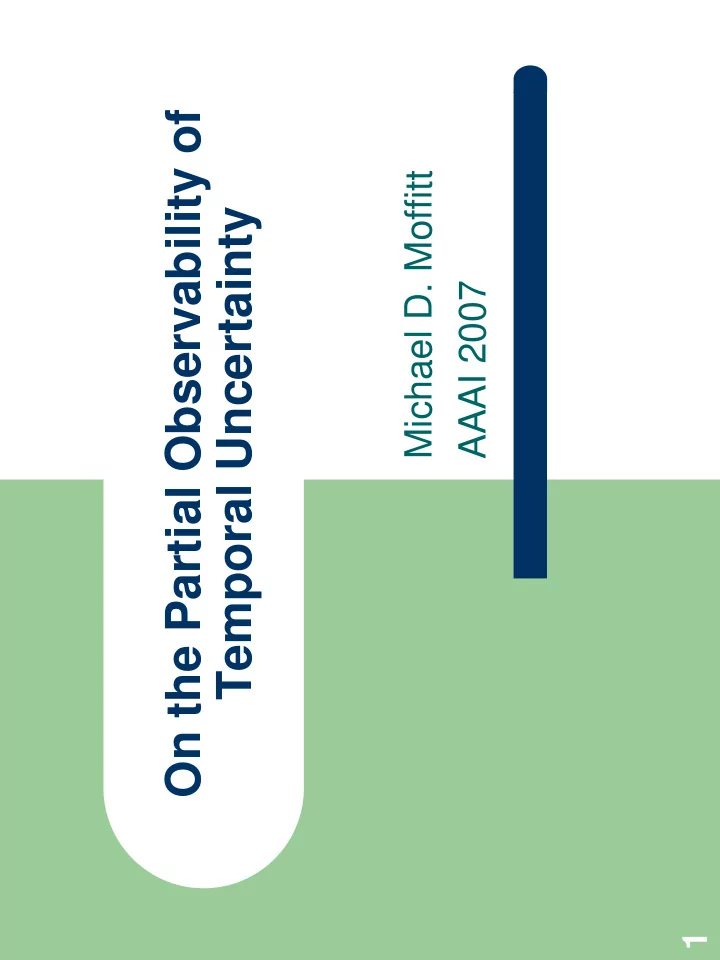

On the Partial Observability of Michael D. Moffitt Temporal Uncertainty AAAI 2007 1
Outline � Introduction � Background � Shared Temporal Causality � The Partially Observable STPU � Algorithms for Dynamic Controllability � Conclusion and Future Work 2
Introduction � Uncertainty in constraint-based temporal reasoning: time points are divided into controllable and uncontrollable events. � Prior studies of uncertainty in Temporal CSPs have required a direct correspondence between observation of an event and its actual execution. � The author propose an extension to the Simple Temporal Problem with Uncertainty, in which the agent is made aware of only a subset of uncontrollable time points. 3
Background 1/5 Simple Temporal Problem (STP) The “Jon and Fred travel to work” Example � Definition : a pair <X, E>, X i : time point, E ij : constraint � Graph-based encoding � Consistency : no negative cycles � Algorithm : Floyd-Warshall, polynomial time 4
Background 2/5 The running example T: current time G1: guest 1 arrive G2: guest 2 arrive M: medication Example 1 : Mrs. Smith is expecting two family members to visit for dinner. The first guest will arrive in 1 to 2.5 hrs; the second guest will arrive in 2.5 to 4 hrs. Mrs. Smith must take medication 1 to 2 hrs prior to dinner. 5
Background 3/5 Simple Temporal Problems with Uncertainty (STPU) � Extension to STP to deal with uncertainty � Defined by < Xc, Xu, E, C> � Xc : controllable time points, M Xu : uncontrollable time points, G1, G2 � E : requirement links, M->G2 � C : contingent links, E->G1, E->G2 6
Background 4/5 Controllability of STPU � Weak Controllability : for every possible projection, there must exist a consistent solution. � Strong Controllability : there exists a single consistent solution that satisfies every possible projection. � Dynamic Controllability : there exists a strategy that depends on the outcomes of only those uncontrollable events occurred in the past. Dynamic controllability is computable in O(N 4 )- time. (Morris 2006) 7
Shared Temporal Causality 1/3 � Example 2 : Uncertainty was due to unknown traffic conditions. Considering the routes both guests take, we can expect the second guest arrive between 1.5 to 2.5 hrs after the first. T → C: a common contingent process 8
Shared Temporal Causality 2/3 By analysis of the subnetwork (C, M, G2), we can infer a lower and � upper bound on C->M: [ub(G2-C)-ub(G2-M), lb(G2-C)-lb(G2-M)]=[60,60] So Example 2 is dynamically controllable with the strategy M=C+60. � � A subtle fault: Our plan cannot depend on C, since C ’ s corresponding causal process is hidden from view. 9
Shared Temporal Causality 3/3 � Another Hidden Temporal Causality example: Deep Space One (DS1) spacecraft controlled by the New Millennium Remote Agent (NUMA) — one of the earliest applications of temporal reasoning with uncertainty. (Muscettola, 1998) � Need to seek a relaxation to the STPU that can accommodate partial observability. 10
Partially Observable STPU 1/2 � Extension to the STPU to deal with partial observablility. � Defined as <Xc, Xo, Xu, E, Co, Cu> � Xc : controllable Xo : observable uncontrollable Xu : unobservable uncontrollable � E : requirement links � Co :observable contingent links Cu :unobservable contingent links 11
Partially Observable STPU 2/2 A Partially Observable STPU is Dynamically Controllable if there exists a strategy that depends on the outcomes of only those uncontrollable, observable events that have occurred in the past. 12
Algorithms for Dynamic Controllability - Original Reduction Rules The labeled distance graph characterized for STPU. � Tightening of edges is achieved by a set of reduction rules. � A strongly polynomial-time algorithm for dynamic controllability is obtained � by repeatedly applying these rules until a certain cutoff is reached. 13
Algorithms for Dynamic Controllability - Augmented Reduction Rules 1/3 � O makes C sufficiently Observable to A by two conditions: 1) O must be sufficiently punctual (z<=x): it must be always possible for A to occur during or before O. 2) O must be sufficiently informative (z-z ’ <=x-x ’ ): the width of the interval on C->O must be no greater than the width of interval on C->A. � Theorem: If C is sufficiently observable to A via O, the subnetwork is locally controllable. (i.e., we can dynamically determine a value for A following O that satisfies the requirement link C->A) 14
Algorithms for Dynamic Controllability - Augmented Reduction Rules 2/3 � Definition : Given an unobservable, uncontrollable event C, we define Ripples(C) as the set of uncontrollables that lie at the conclusion of a contingent link that begins with either C or another unobservable uncontrollable in Ripples(C). 15
Algorithms for Dynamic Controllability - Augmented Reduction Rules 3/3 Replace the function Must-Precede() � Line 2: If C is an unobservable uncontrollable and event A will not be � subsequently scheduled by nature, Line 3-5: examine each observation point O in Ripples(C) to check if it is � sufficiently punctual and sufficiently informative. � Line 6,7: If both conditions are met, then sufficient observability is ensured. 16
Algorithms for Dynamic Controllability - Incompleteness and an Open Problem � A network where sufficient observability does not necessarily guarantee global dynamic controllability. � When X=3: if both C and C ’ occurs as late as possible, waiting for observables require A ’ to execute no earlier than 4+2+4+2=12 units after D, violating upper bound of 11. 17
Conclusion � A new formalism — Partially Observable STPU, extends the STPU to include unobservable events. � A re-characterization of its levels of controllability � A sound extension to the reduction rules for maintaining the labeled distance graph. 18
Future Work � Resolve the complexity class of dynamic controllability � Extending the linear cutoff algorithm to be applied to POSTPU. 19
Recommend
More recommend